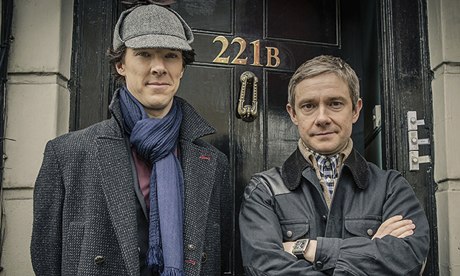Need an extra dose of Sherlock? Head to the art shrine where he fell
Graffiti near Bart's hospital inspired by the BBC's Sherlock adds a new dimension to Arthur Conan Doyle's vision of London

Sherlock: Benedict Cumberbatch and Martin Freeman return for a third series … despite Holmes's 'death'. Photograph: Robert Viglasky/BBC/Hartswood Films
Sherlock has created its own strange world of street art. Like clues left by Moriarty, or an enigmatic code inscribed by the supposedly dead detective himself, a variety of messages mark a London street at a particularly poignant place.
I was walking past Bart's hospital, thinking about anything but Sherlock, when I suddenly noticed the scribbles all around me, in a phone box, on the pavement, even on the hospital windows (written from inside).
Then I realised: this is where Sherlock fell at the end of the second series of the BBC reimagining of Arthur Conan Doyle's great Victorian detective.
Perhaps it's no surprise, given how long we've had to wait to find out howSherlock survived the Reichenbach Fall, that so many fans have felt moved to visit the site of his "death" and leave declarations of faith such as "I believe in Sherlock" or "I still believe in Sherlock". There's also one message from Moriarty.
These Holmesian graffiti resemble the arcane cryptology that is so much part of Conan Doyle's original tales. In the Sherlock Holmes stories, London is a city of signs waiting to be read. A man is invited to join a Redheaded League. What can be the significance of these redheaded men banding together? Why is a man in another story terrified of receiving an orange pip in the post? And why did a murdered woman speak with her last breath of a sinister "speckled band"?
It is by decoding these bizarre symbols that Holmes deciphers the criminal secrets of 19th-century London. In their witty update of Sherlock,Steven Moffat and Mark Gatiss turned to graffiti art as a 21st-century urban arcanum. In one episode, Sherlock consults a street artist who is painting outside the National Gallery – and when the police come Watson is left holding the can.
Cities are forests of meaning. Urban underworlds can be found through the strange clues they leave. This is one of the insights of Conan Doylethat makes his tales of London's cerebral superhero so timeless they can be transposed to a world of smartphones without losing their atmosphere. It's fitting that Sherlock has now added its own mysterious inscriptions to the mysterious streets of London.
No comments:
Post a Comment